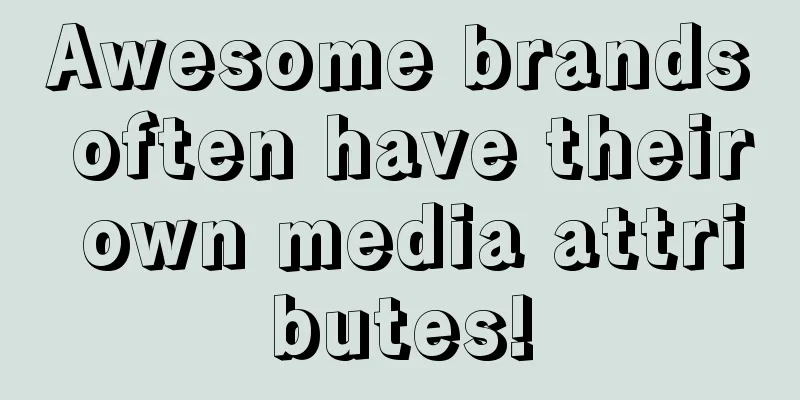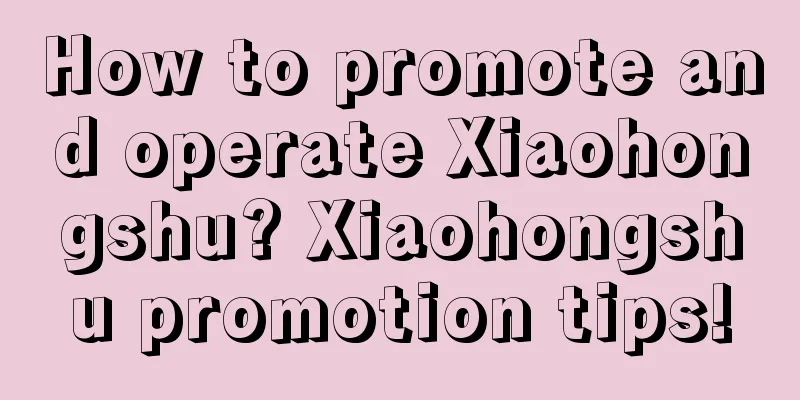Awesome brands often have their own media attributes!

Most super brands are creators of new categoriesWe all know that in the traditional marketing theory STP strategy (market segmentation > target market > market positioning), market positioning is the most important link, and its core is the three words "differentiation". But I think the complete positioning theory cannot be summed up in just three words: “differentiation”, because in real life we can see that brand positioning is actually divided into three types, namely: differentiated brand positioning - differentiated brand positioning - unique category of brand positioning, and these three are in a progressive relationship with each other. Let me give you an example. Type 1 (General Brand): DifferentiationIn today's buyer's market-oriented business environment, it can be said that every company is making every effort to pursue product differentiation. However, in fact, according to my observation, most companies have not even differentiated their brands, let alone differentiation. For example: As for soy sauce, its selling points may be "fresh" and "healthy", but there is one special thing about these selling points, which is that they are often difficult to reflect.
Therefore, the first thing to do for this type of product is to achieve the simplest and most basic brand differentiation, and then pursue brand differentiation. For example: you can make differentiated designs on the product's visual packaging and shape, so that users can recognize the product immediately and clearly. Basically, it can be judged that the positioning and differentiation have been successfully carried out. Example: When you see the bright green shop sign from a distance, you can basically tell that this is the "Guerlain" store. Type 2 (Top Brands): DifferentiationPositioning differentiation is particularly evident in the mature industry of the automotive field. For example, when you mention "safety", the first thing you think of is Volvo ; when you mention supercars, the fiery red Ferrari brand immediately comes to mind. When it comes to "driving pleasure", BMW must be mentioned. These positioning differences have long been firmly implanted in the minds of consumers. The third type (phenomenon brand): self-made categoryA unique category means that in a sense it is equivalent to a brand new category. Typical examples are: the herbal tea beverage Wanglaoji (not to mention the disputes in the past two years), Apple mobile phones (Apple phones and Android phones); these brands in unique categories are often pioneers and leaders in an emerging market, and they firmly control the rules of the game , pricing power, and high profits in their own hands. When consumers are faced with this kind of product, their consumption decision often subconsciously changes from (I’m thirsty > buy a bottle of mineral water > buy Yilibao) to (I’m thirsty > buy Wanglaoji), directly skipping the brief category thinking stage. Correspondingly, the three categories mentioned above are like this in the minds of consumers. This is how phenomenal brands communicate with users To create a brand like Apple, it is far from enough to just have extremely advanced products. If you want users to go from knowing - recognizing - buying - falling in love - to being fanatical about your brand, you must change the conventional way of brand communication. Let’s take a look at conventional brand communication methods. They often follow this pattern: launch new products – package selling points – guide purchases. For these companies, consumers are often just consumers of their products. How does Apple communicate with consumers? Their model is this: output values —— design products based on values —— Do you want to buy one? The scary thing about this marketing method is that Apple’s consumers are not consumers of its products, but consumers of its values. So whether Apple launches the iPhone, iPad, Mac, Apple Watch, etc., consumers are willing to pay for them - because they recognize Apple's values. The same logic applies to MUJI . Awesome brands often have their own media attributesA great brand is, in a sense, a media. For example, Xiaomi mobile phone, for example, Luoji Siwei . Every new product launch and every marketing move they make will attract media attention. Their brands already possess "media" attributes in a certain sense and fully enjoy the benefits of media exposure. The hot fried chicken must walk on two legs at the same timeI have always believed that in order to become a phenomenal brand, you must balance these two points:
If you only focus on market share, look back at HTC 5 years ago. Those who only think about occupying the minds of consumers but do not quickly seize market share and keep consumers on suspense will eventually backfire - such as LeTV . The author of this article @Allen compiled and published by (Qinggua Media). Please indicate the author information and source when reprinting! Product promotion services: APP promotion services, information flow advertising, advertising platform |
<<: 5 tips and 3 misunderstandings for high-conversion information flow copywriting!
>>: Sogou promotion case: a high-quality traffic expansion solution that increased clicks by 60%!
Recommend
How does product operation achieve user growth?
Recently I saw a growth-related topic on Zhihu, w...
Is there another core hidden in the Earth's inner core?
The Earth is the common home of all living things...
Tesla's domestic production is finalized and will be put into production in 2020
As a huge consumer market for electric vehicles, ...
Flink Principles and Implementation: Architecture and Topology Overview
To understand a system, we usually start with the...
Bidding promotion: 6 secrets to high conversion!
A few days ago, someone chatted with me and said:...
Kia Proceed GT spy photos may debut in 2019
Recently, we obtained a set of road test spy phot...
Dry eyes...how did it become a terminal illness?
How many times have you watched "Kuaisan&quo...
The dirty tricks ransomware uses to fool us
[[167210]] Finding ransomware... Today, ransomwar...
AI is taking programmers' jobs: AI may replace programmers in 2040
Some experts at Oak Ridge National Laboratory in ...
App launch growth: user awakening methods
In daily App promotion , attracting new users and...
Google, BlackBerry team up to make Android devices more secure
BlackBerry has announced a partnership with Googl...
How to avoid remote work failures: DingTalk, WeChat for Work, or Lark, which one is more suitable for you?
The COVID-19 pandemic has brought online office w...
National Eye Care Day丨Share these eye protection tips with the ones you care about!
Today (June 6) is National Eye Care Day. Eyes are...
Everyone is talking about user growth, have you avoided these 3 pitfalls?
In my book "Exploding User Growth ", I ...
Don’t be careless if you experience these 5 abnormalities in your body, they may be signs of lung cancer!
Recently, according to Beijing Youth Daily, Mr. L...









